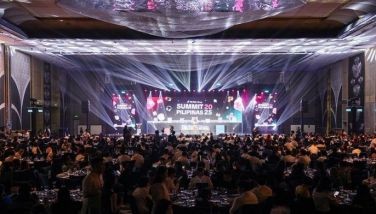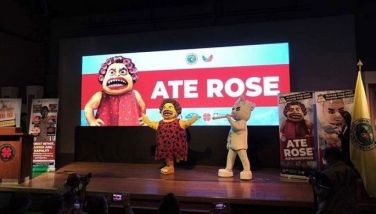Carving a name in the art scene
October 29, 2001 | 12:00am
 It has been a hectic artsy few weeks with exhibition openings, performances and awarding ceremonies. The more outstanding of these were marked by fresh approaches to art and a defiant mood away from some of the local arts institutions’ boring conservatism and unimaginative programs. Despite – or perhaps indirectly as a result of – war, anthrax and economic woes – some of the artists I know have been showing their resolve to do their best. Nothing is stale about creative projects that have come out of the whirl of recent art events. Some of these have given me a glimpse of the bracing orientation of new art.
It has been a hectic artsy few weeks with exhibition openings, performances and awarding ceremonies. The more outstanding of these were marked by fresh approaches to art and a defiant mood away from some of the local arts institutions’ boring conservatism and unimaginative programs. Despite – or perhaps indirectly as a result of – war, anthrax and economic woes – some of the artists I know have been showing their resolve to do their best. Nothing is stale about creative projects that have come out of the whirl of recent art events. Some of these have given me a glimpse of the bracing orientation of new art.
Normally I do not write about my own projects but I will take exception if only to acknowledge the energy and verve of the people involved in it. As the curator of the newly opened 2001 Young Sculptors’ Show, I learned a few things about passion that has fueled much of the excellent art included by the eight sculptors for the exhibit. Even their old works in the brief survey appeared novel, partly as a result of the way we negotiated spaces for their works and how the artists worked with each other. The setting also helped. The Enterprise Center’s Central Lobby has little architectural detail, good natural and electrical lighting system and a huge space. At nearly 30 feet high, one British viewer remarked that "the exhibit has a museum feel about it."
Indeed the notion of permanence and stability marked the quality of the show beyond the appearance of its sculptural forms. It is perhaps the desire of the participating artists to create and display enduring art, sharply contrasting with the present situation where things constantly change around us. Our everyday lives seem so rudely interrupted where suddenly nothing is revered anymore. It is interesting how art can present visions of the alternative and make us believe in concepts behind them.
This belief also came through with HSBC’s support for the project. Without these contexts, the impulse of the eight artists would sooner be crushed by the weight of obstacles that seem to pervade in contemporary artmaking in this country. One question that struck me was why museums in this country provide little space for creativity and puissance. It had to take the help of the people behind HSBC and The Enterprise Center to make it possible for the sculptors to participate in this show. They have even extended the exhibition up to Oct. 31, encouraged by the response of those who have seen it.
This feeling of rapture began before our opening. I must admit to having seen Ballet Philippines’ Shoes two times at the CCP’s Main Theater. I had so much fun the first time I saw it that I had to go back for more. The wonderful dancing inspirited by striking music and choreography was possible in part with the support from benefactors and the audience who believed in them.
Just like a visual arts exhibits, settings always matter in helping to show artistic endeavors. I am certain that the dancers were also inspired by the spry set, costume and lighting design of the production. The set and costume designer was Gino Gonzales, who recently returned from a Fulbright Scholarship to New York University. Katsch Catoy alternately lighted his grid translucent shoe shelves from the back or front.
Gonzales’ set design using the grid not only served as a backdrop; it also conveyed a sense of space. Yet it enhanced rather than competed with the performances. His solution to create depth was addressed by placing the grid- like shelves in an oblique way, making the audience aware of the three-dimensionality of both his design and the dances. Rectangular archways were sometimes used as entrances or were integral to the dance sequences. I was awed by the way it seemed to convey a mood, depending on the intensity and color of the lighting. The translucent grid reminded me of those glass blocks much in vogue in the 1950s and is having a comeback in residential areas. They provide pockets of light in homes and buildings.
This crisp approach to art is also evident in products of younger artists who joined the sculpture contest of the 34th Shell National Students Art Competition. I was delighted to be one of the members of the jury, which included Ateneo’s Dean for the School of Humanities Leo Garcia, Architect Honrado Fernandez and Drawing Room owner Jun Villalon (sculptor Solomon Saprid was ill at that time and could not join us). We were one in voting Christopher Manalang’s relief as first prize for sculpture. Using different shades of soap, from creamy white to light brown, Manalang carved out 24 small rectangles of popular religious icons and set them on a frame. On one level, they resembled a mini retablo, depicting the life of Jesus Christ. But because they were small, the carved and sometimes layered soap can allude to istampita or medallions worn with ribbons around the neck of devotees.
Manalang, who is a University of the East art student, displayed his patience and skill at carving soap, revealing the Filipino sensibility of making do with whatever material is available. As judges we had to argue with the contest organizers over the sculpture’s durability. Left exposed in tropical weather, soap can be eaten up by insects, absorb moisture, and deteriorate. But no art material is truly permanent and the notion of endurance in contemporary art these days have more to do with concept rather than on product alone. It is up to competition organizers whose clients buy the winning entries to seek advice on ways to conserve the artworks. This should not be the basis for eliminating a piece of work entered into competition that is otherwise artistically ahead of all others.
In contrast to Manalang’s relief sculpture, the rest of the winners made sculpture-in-the-round. For the second place Rexell S. Livelo of Philippine Women’s University used terracotta to model a working class family with surreal faces who seem to be all laughing or grimacing from an untold pain. His handling of clay was remarkable, managing to include details such as the father’s droopy eyes, missing teeth and his rolled up shirt. Livelo even included a dog lying prostrate on the floor scratching its tummy, reminding me of Danilo Dalena’s dogs in his series of paintings done in Pakil, Laguna. The third place winner, UP Diliman’s Carl Christopher Plaza Loquias, created two head portraits placed at the back of each other. One is made out of sawdust and glue (modeling) and the other with fiberglass (casting). The cast was probably based on the model.
Noel Borlongan of La Consolacion College, Bacolod City, who gained an honorable mention, also did modeled figures. These terracotta figures that symbolized cruelty, slavery and lust were set on a wood frame that also doubles as its carrying case. Two others who got honorable mention places made sculptures that were architectural in their construction and would probably look better as a large-scale work in open air spaces. Both Ferdinand Mark J. Basa of UP Diliman and Ariel A. Carlos of Adventist University of the Philippines created symbolical pieces that allude to circular patterns of flux and undulating lines.
I was told by the Shell competition organizers that the sculpture category is relatively new although the painting category has been running since Shell began the scheme in the 1950s. Some of today’s renowned artists, including Ang Kiukok, Ben Cabrera and Jose Joya, won in this juried art contest. In a sense opportunities like this one helped to make artists’ reputations and sometimes bolstered their careers. Shell stood out as being one of the first of its kind in the Philippines that focused on art students. The dizzying number of contest around has meant more chances for artists to build their names in the competitive world of art. But more should be done for artists in terms of institutional support and creating an atmosphere that both challenges and inspires them to make art that is imaginative, critical and skilled.
The pressures of commercial enterprise have contributed to the humdrum art we see around mall galleries. This has also affected the artworks entered into competition by seasoned artists in other just recently concluded art contests. Surely this is not reflective of today’s Filipino art. I think it is sad that the Shell exhibit took place at the mezzanine of the central mall in the Greenhills Shopping Center. Organizers informed me that their usual place, the Shangri-La Plaza, increased their fees, making it too expensive to exhibit the students’ artworks.
Ironically, both Shell and Shangri-La Plaza profit millions from their respective businesses. A little more generosity and creative fund raising will go a long way in terms of providing the much-needed support especially for young artists and new art. The Enterprise Center, HSBC, donors of Ballet Philippines and Fulbright scholarships have shown in their recent arts projects that as a result of their assistance Filipino artists are keeping contemporary art fresh.
BrandSpace Articles
<
>




















